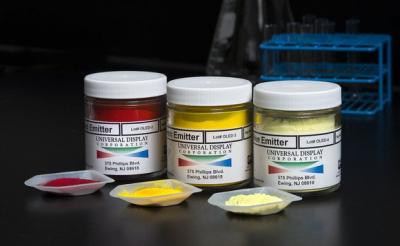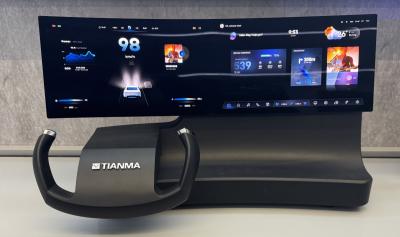 Corning is one of the world leaders in glass and ceramics - working on these materials for 150 years. Corning is active in several markets - display technologies, Environmental technologies, telecommunications, life sciences and others.
Corning is one of the world leaders in glass and ceramics - working on these materials for 150 years. Corning is active in several markets - display technologies, Environmental technologies, telecommunications, life sciences and others.
Corning has three products aimed for OLEDs:
- Lotus Glass, suitable for high-end OLEDs and LCDs (Lotus replaced the old JADE OLED glass product)
- VITA, hermetic sealing solution for OLEDs (available for licensing only)
- Willow Glass: ultra slim (50 and 100 um) flexible glass that can support backplanes and color filters in both LCD and OLED panels and be used in R2R processes.
In February 2012 Corning announced that it will form a new joint-venture with Samsung that will produce Lotus Glass for OLED displays in Korea. That glass plant is now up and running, and Samsung is already using Lotus glass panels from that plant in their OLED smartphones and TV panels.
In 2017 Corning announced that Samsung is adopting its Lotus Glass NXT in its Galaxy S8 smartphones as a carrier glass.
One Riverfront Plaza Corning
Corning, NY 14831
United States
Tianma and Corning show a dual-screen multi-curved color-matched automotive OLED display
At CES 2025, Tianma unveiled a new display prototype that it has developed in collaboration with Corning. This is an automotive OLED display that is made from two 13-inch AMOLED panels. The company says the new display offers "unparalleled visual clarity in automotive applications".
The new OLED display features a unique multi-curvature design, with a left curvature radius of R800mm for optimal driver focus, a middle curvature radius of R1140mm, and a right curvature radius of R2160mm to accommodate the passenger. The system seamlessly bonds two color-matched 13" OLED displays to the multi-curve cover glass made possible with Corning ColdForm technology.
Tianma shows its latest OLEDs and MicroLEDs at Displayweek 2024
China-based Tianma had an impressive booth at Displayweek 2024, showing numerous OLED and microLED displays and prototypes.
For the automotive market, Tianma showed three new display prototypes. First up is a 13" slidable OLED, with an embedded touch panel, aimed towards car dashboards or center controls.
UDC announces new narrow-spectrum PHOLED materials, reports advances in OVJP deposition technology
Universal Display announced that it will detail advances in its latest PHOLED materials at Display Week 2023. The company's latest red, green, and blue PHOLED materials offer a narrow emission spectrum, which increases the efficiency of OLED devices, in addition to enhancing the color gamut.

UDC also unveil a new OVJP system printed on a 200mm x 500mm Corning Astra Glass substrate. UDC will also showcase the first-ever fully printed seven-layer (HIL/HTL/EBL/EML/HBL/ETL/EIL), 80 PPI, green commercial-level PHOLED device fabricated by its R&D OVJP system that has comparable device performance with vacuum thermal evaporation (VTE).
OLEDWorks shows new flexible and rigid automotive OLED lighting solutions
Last week at CES, OLEDWorks demonstrated some of its latest automotive OLED Lighting solutions. Developed together with Corning, Valeo and STMicroelectronics, OLEDWorks’ newest demonstrator contained the highest density of individually addressable segments of any flexible OLED panel.
You can see the new flexible OLED demonstrator in the video above on the left (the device on the right uses rigid OLED panels). OLEDWorks says that individually segmented OLED lighting panels increase safety on the road by allowing for improved communication through dynamic animation sequences and symbols. Manufacturing these OLED panels on flexible glass further expands lighting design opportunities with the ability to conform with curved surfaces in the car, integrating lighting directly into the vehicle’s architecture.
DSCC details Samsung's upcoming foldable OLED phones
DSCC posted an interesting blog post in which the company shares its information on Samsung's upcoming foldable smartphones.
 Samsung Galaxy Z Flip
Samsung Galaxy Z Flip
First up is the Galaxy Z Flip 3 (which is a bit strange as there's no Galaxy Z Flip 2). This new phone will feature an Ultra Thin Glass cover - which for the first time will not be exclusively produced by SCHOTT. This time Corning will supply some of the UTG for Samsung. According to DSCC, Corning’s UTG will be processed by Korean supplier eCONY. This is interesting - a while back it was reported that Samsung Electronics halted its UTG project with Corning.
Samsung Electronics halts its foldable UTG glass project
Samsung Electronics started to adopt ultra-thin glass covers for its foldable AMOLEDs, instead of polyimide, as it says UTG offers higher durability. Samsung currently uses Samsung Display's UTG, and according to reports it aimed to develop its own solution in collaboration with Corning

A new report from Korea suggests that Samsung Electronics has halted this project as it realized it should better increase the efficiency of its current supply chain (i.e. Samsung Display's UTG solution) and secure lower prices. It may be that this decision is only temporarily, as it is likely that Samsung Electronics is still aiming to also increase the durability of its UTG covers and not just decrease costs.
Samsung Electronics collaborates with Corning on Ultra Thin Glass technology for foldable OLEDs
Samsung started to adopt ultra-thin glass covers for its foldable AMOLEDs, instead of polyimide, as it says UTG offers higher durability. In the Galaxy Z Flip, Samsung used a UTG cover produced by Korea-based Dowoo Insys, who processes Schott's ultra thin glass for Samsung Display.

In April 2020 it was reported that Samsung Electronics wants to develop its own UTG cover technology, as as it feels that Samsung Display's UTG is still not robust enough and the company also wants to increase production yields and reduce costs. Now there are new reports from Korea that say that Samsung Electronics is collaborating with Corning in this new UTG project.
OLEDWorks flexible OLED lighting panels, now branded as Wave, are now commercially available
In March 2018 OLEDWorks launched its first flexible OLED panels, branded as BendOLEDs. The company now announced that the panels are now commercially available - and rebranded as LumiCurve Wave, which is the first panel in OLEDWorks LumiCurve product family.

The LumiCurve Wave is produced on Corning's 0.1mm thin Willow Glass flexible glass substrate. OLEDWorks says that the Wave panels are extremely thin and light and deliver the superb light quality and excellent color rendering that is uniquely achievable with OLED.
Corning announces that Samsung uses its Lotus NXT as a carrier glass in flexible OLED production
Corning announced that Samsung Display is using the company's Lotus NXT glass as the carrier glass in its latest flexible OLED panels, including those that are used in the Galaxy S8 and S8+ smartphones. Both these new flagship phones also adopt Corning's Gorilla Glass 5 cover glass.

Samsung Display is producing its flexible OLEDs on a flexible polyimide substrate, and the Lotus NXT glass is used as a carrier glass during production (it is removed at the end of the process).
Corning and OLEDWorks announce the winners in their OLED lighting design contest
In April 2016 Corning and OLEDWorks launched an OLED lighting design contest , calling designers to integrate thin, lightweight and cool-to-the-touch OLEDWorks lighting panels into functional luminaires that are practical yet creative.

Corning and OLEDWorks now announced the winners of this content - Matthew Boyko, Mike Garner from MSG Lighting, and Sadyr Khabukhayev. The winners were awarded $10,000 each for their innovative lighting luminaires which ranged in design from horizontal lighting arrays, to the integration of OLEDs into triangular storage modules, as well as a creative way to install OLED panels.
Pagination
- Page 1
- Next page



